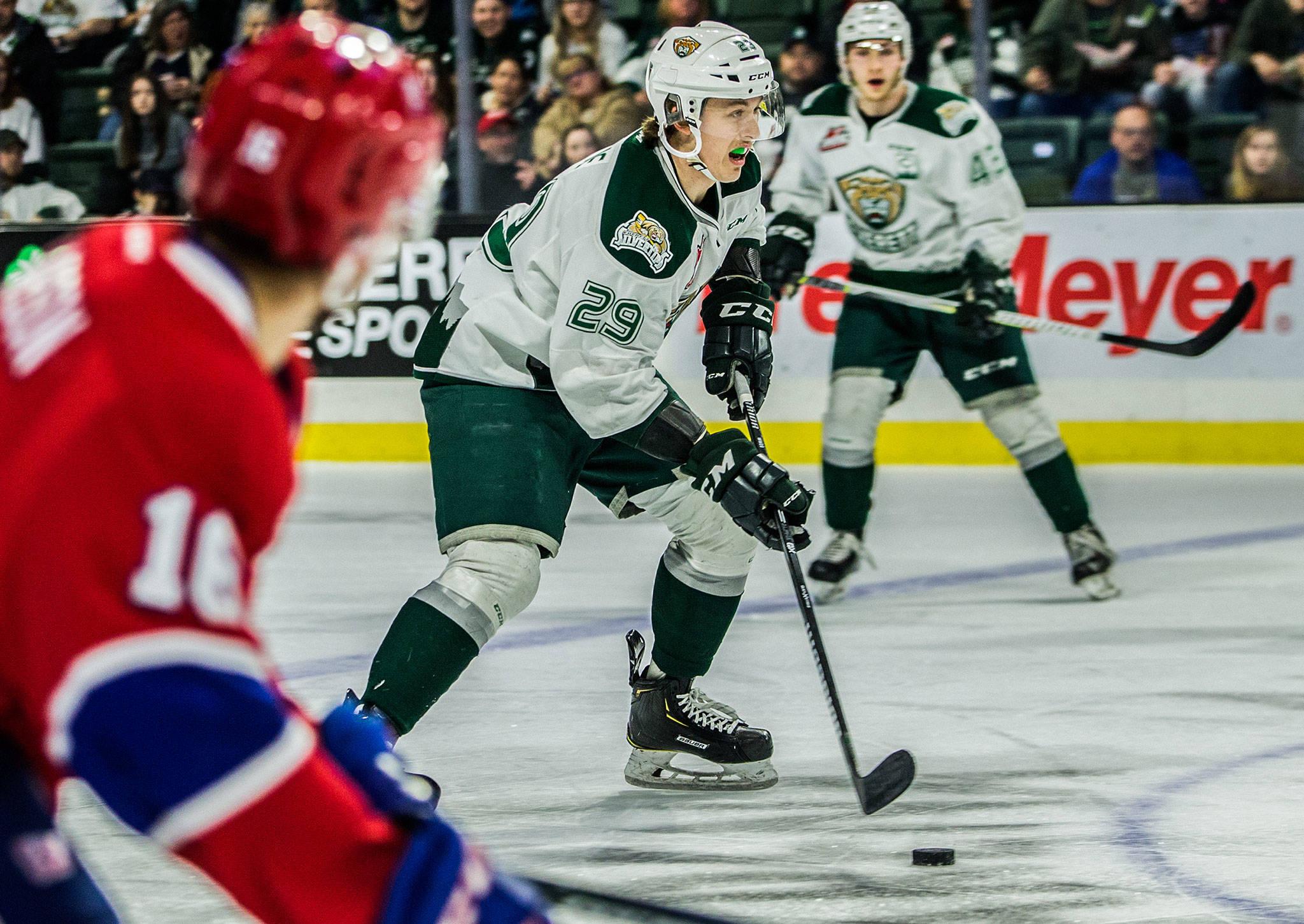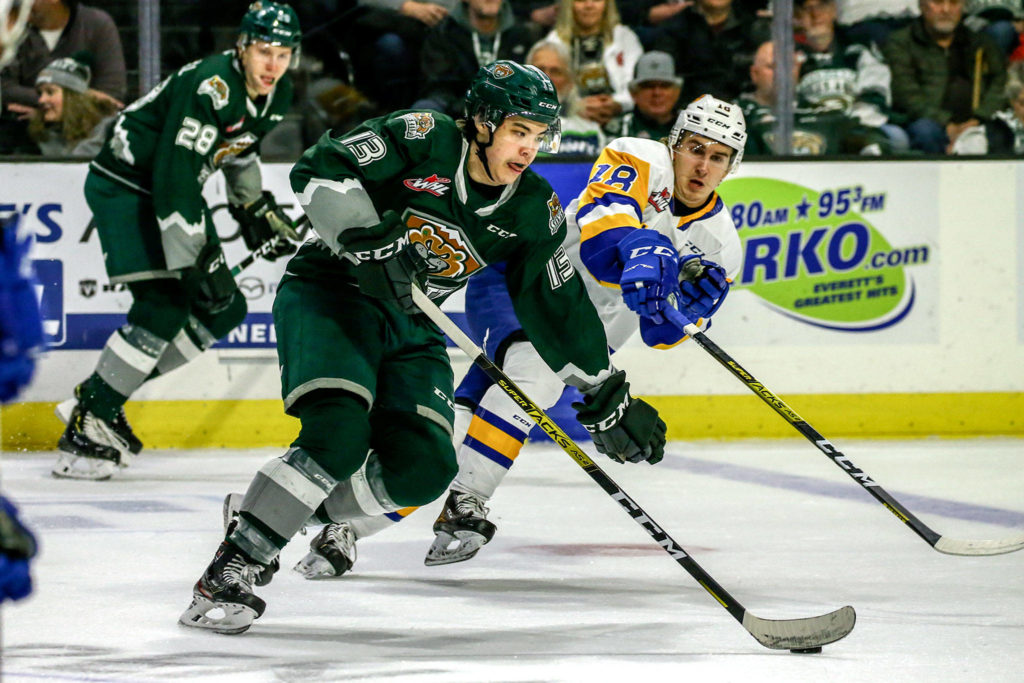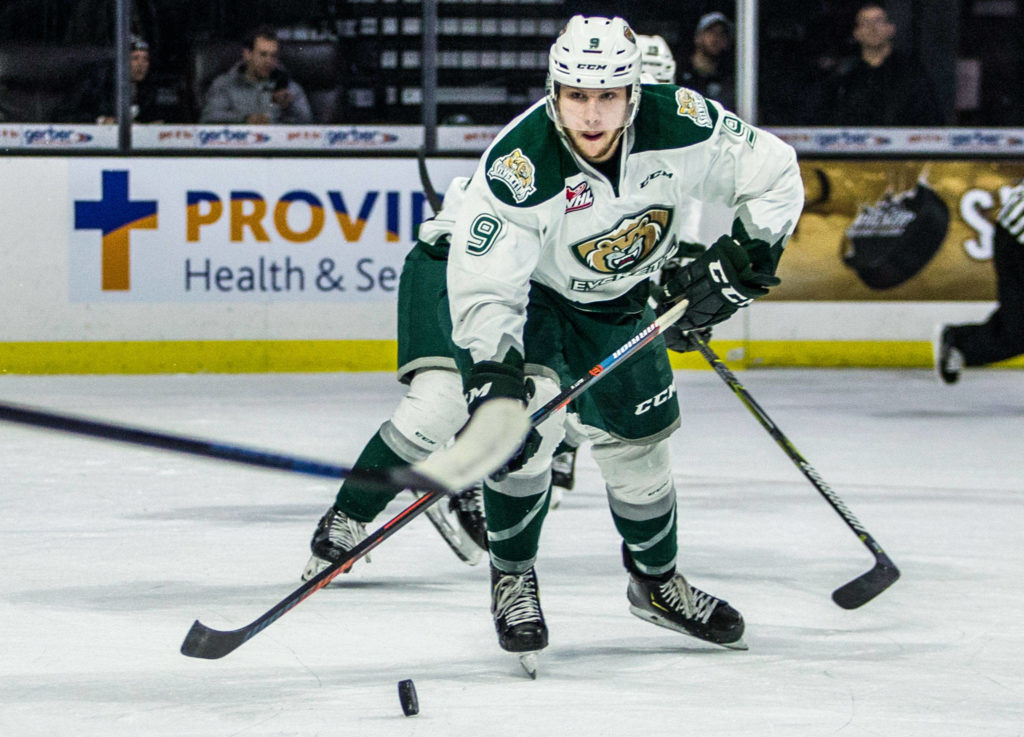Just one.
That’s how many Americans were on the Everett Silvertips’ 50-player protected list when Garry Davidson took over as the Western Hockey League team’s general manager in 2011.
Things have changed.
This season’s roster includes six Americans — defenseman Wyatte Wylie, forwards Dawson Butt, Hunter Campbell and Brendan Lee, and goaltenders Dustin Wolf and Braden Holt. That’s the highest number of U.S. players on the Tips’ roster in Davidson’s nine-year tenure. And that doesn’t include goaltender Keegan Karki, who was traded in January, or signed prospect Jack Lambert, who played a few regular-season games at the start of the season before being re-assigned to the Junior Silvertips program.
More could be on the way.
Everett selected five Americans in the 2019 bantam draft. Two of them, fifth-round picks James Hong and Matthew Ng, were the third and fourth players taken by the Silvertips.
Even though American players are notoriously difficult to recruit to the WHL, the Silvertips haven’t shied away from expending draft capital and recruiting time on bringing more of them into their program.
That’s no accident.
“There’s no question since I’ve arrived that we’ve tried to assert ourselves in the U.S. market,” Davidson said.
Emulating Portland
Under general manager and head coach Mike Johnston, the Portland Winterhawks have developed into the gold standard in the WHL when it comes to successfully recruiting players from the United States.
“Our emphasis from day one to our scouting staff was to draft the best players,” said Johnston, who took over in Portland in 2008. “What I heard coming into the league was that it was really challenging to get American players to come to our league.
“It didn’t matter to me where the player was from. We just drafted the best players. I told our scouts then that it’s my job to try and recruit them and get them into our program.”
Davidson served under Johnston as Portland’s director of player personnel from 2008 to 2011. When Davidson left Portland, the Winterhawks had eight Americans on their roster, an unusually high number for a team in the Canadian Hockey League, the umbrella organization that oversees North America’s three major junior hockey leagues.
Everett, Portland and Spokane each have a WHL-leading six Americans on their rosters this season. While the teams in the WHL’s U.S. Division typically have more success landing talent from the United States than do their Canadian rivals, it’s not because of a fool-proof recruiting pitch or a specific strategy. It’s a numbers game, Johnston said. American-based teams are more willing to pursue players from the United States, but the success rate across the league remains fairly constant.
“I wouldn’t say our success rate in getting them is better than any other teams in our league,” Johnston said, “because some teams only list five and only get one (American). The same goes for us. If we list 10, we’ll probably only get two.”
It isn’t easy recruiting Americans
The Silvertips participated in their first WHL bantam draft in 2003. When Everett made the first pick of the second round, longtime Silvertips scout Doug Sinclair said he heard some chuckling from the other tables.
The Silvertips selected forward Peter Mueller, who hailed from Bloomington, Minnesota, a state that was, and remains, notoriously difficult for WHL teams to recruit from. Just 82 players from the state known colloquially as “The State of Hockey” have played in the WHL since 1965, according to Quanthockey.com — despite Minnesota consistently pumping out high-end talent.
Fortunately for the Silvertips, Mueller signed and played two seasons in Everett before moving on to the NHL’s Arizona Coyotes.
Minnesota remains a difficult area to recruit, but with an increase in the number of kids playing hockey in the U.S., the player pool has grown. From 1998 to 2017, participation in all levels of hockey in the United States grew 28.8%, according to Sports Business Journal. The WHL has reaped the reward, as the number of U.S. players in the league grew from 11 in 1998-1999 to 55 this season.
Yet, the WHL has struggled to land the top-end American players.
Of the 19 American players taken in the 2019 NHL Draft who hail from states west of the Mississippi River — the area from which the WHL draws its U.S. talent — just two opted to play in the WHL. The rest either played NCAA Division I hockey last season or are committed to NCAA schools.
Part of the problem, was the WHL’s reputation as a “goon” league, where small, skilled players were deemed likely to get hurt in a league that welcomed fights and rough play. But with hockey in general trending away from line brawls and rock-’em-sock-’em-type fisticuffs, that’s no longer the case.
“It’s nowhere close to where it used to be,” Davidson said. “We still have fighting, but no one has to come here and worry about having to fight. Because you don’t have to.”
The numbers bear that out. In the 2016-2017 WHL season, 559 fighting majors were assessed by Feb. 12, WHL vice president of hockey Richard Doerksen said. Through the same date this season, there were 383 fighting majors, a decrease of 31%.
Nowadays, Davidson said, one of the biggest obstacles the WHL faces are U.S. parents who are reluctant to send their 16- or 17-year-old son to Canada, where the school and health-care systems are foreign to them.
That’s where teams such as the Silvertips, just one of eight U.S.-based teams in the 60-team CHL, have a distinct advantage.
Another concern U.S. players frequently have with the WHL is the travel. Road trips can be arduous, with long hours logged on charter buses, while NCAA teams often fly to road games. The WHL plays a 68-game schedule, which the league argues is better for development because it mirrors a pro season, but the roughly 30-game schedule in college is often more attractive to American players.
“That’s a hard thing to attract players to: those long, long bus trips and just the way that it is,” said Chris Peters, an NHL prospects analyst for ESPN. “I think geographically you can’t ask for much (more) in terms of scenery and nature and all those other things that are really cool about Western Canada and the Pacific Northwest, but the player doesn’t really know that.”
Even more challenging is the fact U.S. players often are steered toward college at an early age and never consider the WHL.
“It’s like buying a car for me,” Davidson said. “You test drive one, and that’s the one you take. It may not be the best car, the other one was, but you didn’t do your homework on it, so to speak.”
Silvertips defenseman Wyatte Wylie, a Snohomish County native, was almost 4 years old when the Silvertips came to town. He grew up watching and looking up to Silvertips players.
“The (WHL) scared me as a U.S. kid,” Wylie said. “It scares most U.S. kids because they think, ‘Oh you can’t go to college,’ or they just don’t understand. I really looked into it to see what it’s all about and, really, it’s the best league for development. Obviously, you get your school paid for (through the WHL’s scholarship program). You’re not losing anything.”
A U.S. player who signs with a WHL team forfeits his college eligibility.
“It’s why I didn’t sign here as a 16-year-old, because I didn’t know yet,” Wylie said.
Wylie played one year for the Dallas Stars U-16 team in the Tier I Elite League, the premier circuit for American players of that age, before deciding to join the Silvertips. He said Davidson’s interest in him and the opportunity to play for his hometown team were the clinching factors, despite receiving attention from NCAA schools such as Michigan, Ohio State and Miami of Ohio.
The Silvertips’ other four American players all received college interest to varying degrees.
Lee, a Seattle native, heard from Cornell, New Hampshire and Massachusetts before eventually signing with the Silvertips during training camp.
“I came back here for an experience and I just fell in love,” said Lee, who attended Silvertips games growing up. “I fell in love with all the nostalgia during training camp.”
Holt, a Bozeman, Montana native, was being courted by Massachusetts and Maine, but chose Everett because it was a “goalie factory.”
Both Campbell, who was drafted by Calgary but traded to Everett this season, and Butt, who was a teammate of Campbell’s in the Junior Silvertips program, were recruited by colleges but chose the major-junior route because it fit their styles of play.
“I don’t think there is a right path,” said Silvertips head coach Dennis Williams, who is from Stratford, Ontario, but played NCAA hockey at Bowling Green State. “We could sit down for a long time and dive into the pros and cons of each. But every player is different.”
Future for Americans and the WHL
The WHL is making efforts to increase the number of U.S. players.
This past weekend, the league held the first-ever WHL U.S. Challenge Cup at ShoWare Center in Kent. The tournament — for bantam teams (players born in 2005) — included some of the premier squads from the United States and Western Canada. The Challenge Cup replaced the WHL Prospects Camp that took place each year in Anaheim, California.
Participants in the Challenge Cup were invited to watch Saturday’s Seattle-Portland game.
“The only thing with that (prospects) camp, as good as it was, it didn’t give them a chance to see an actual WHL rink or an actual WHL game,” Doerksen said.
Additionally, the league will conduct its inaugural two-round U.S.-only bantam draft on March 25, meaning 44 Americans will be drafted by WHL teams — and that doesn’t include any additional players who might be taken in the regular bantam draft in May.
“It sure will increase the stature of the players that are being drafted and it places them in a really good order coming out of that draft,” Doerksen said. “In the past, it would be a little hit or miss whether they’d be selected in the regular bantam draft.
“We really think this will be an important step for them.”
How will these changes impact the Silvertips? It’s unclear, but Davidson is optimistic it will help the league as a whole, and in turn, benefit Everett.
“I think it’s a perception thing,” Davidson said. “You can say, ‘We took you in the first round, that’s how highly we thought of you as a U.S. player.’ As opposed to taking him in the eighth round and saying, ‘We didn’t know if you were going to come or not.’
“We’re trying to send a message to U.S. kids that they are a priority for our league. I hope it’s going to work in our favor. I hope the two players we draft both want to come and play for us.”
While Johnston said it can be only positive to have more Americans drafted by WHL teams — there were just 37 picked in last year’s bantam draft — he doesn’t see Americans flocking to play in the league.
“Every team in our league is going to own the rights to two American players, so that’s a positive step,” he said. “Is it going to change the ratio? I don’t think so. I just think that’s just the way it is. It’s very challenging and there’s a lot of options for them. … You have to put a lot of time and energy into recruiting and educating, mainly. Just educating the family that the WHL is the best route for their son.”
Josh Horton covers the Silvertips for The Herald. Follow him on Twitter, @JoshHortonEDH
Talk to us
> Give us your news tips.
> Send us a letter to the editor.
> More Herald contact information.



























